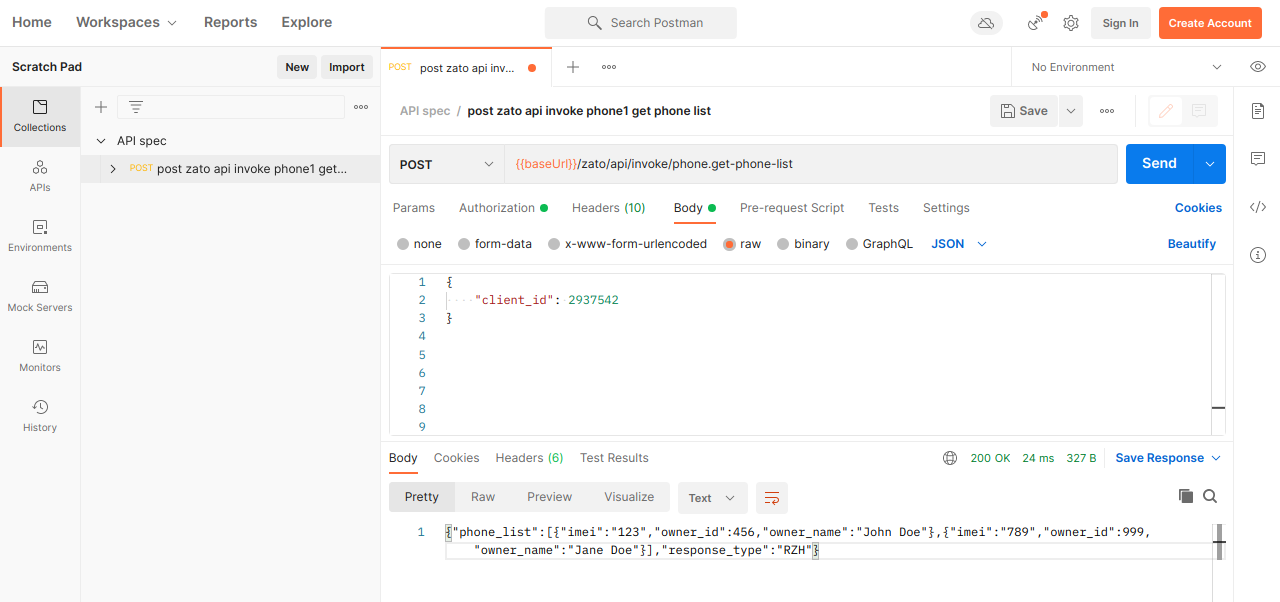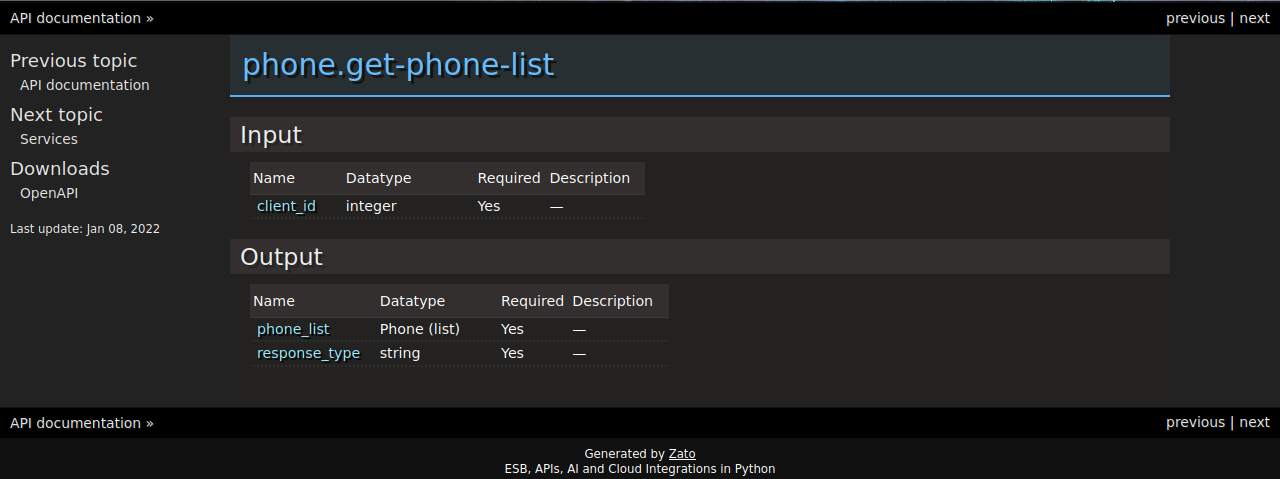Data models and OpenAPI
- Data models for your API services are created using Python's built-in dataclasses
- Models are based on the results of analysis in your business domain and you define the models first, before your services use them
- Models allow for static typing and code completion in your IDE. If anything changes in models that your services use, you will get immediate messages in your IDE or build tools to warn you that you may be, for instance, accessing an attribute of a model that no longer exists - in this way, you can prevent runtime errors well in advance, already during development or testing.
- Models can be hot-deployed to Zato servers without any restart
- Models can be defined in-line, directly in the same Python module that your services are in or they can be defined in a separate file (e.g. model.py)
- In runtime, Zato auto-serializes models to and from JSON, Python dicts and OpenAPI
- Models are not tied to REST - you can use them with any services or systems. For instance, you can have a WebSockets, ElasticSearch, MongoDB or any other service and all of them can use models and OpenAPI
- Models can be generated from external tools, e.g. their canonical form can be expressed in UML and an external tool can build them in Python when needed
Usage example
In the code example below, we assume that we need to represent the following business needs:
- A client has many phones
- Each phone has a few attributes, such as its current card number (IMEI) or current owner
- We would like to have an API service that tells us what phones a given client has
Graphically, it can be expressed as such:

In code, this will be the result as below, where each request, response and model object is a dataclass subclassing a class called Model.
# -*- coding: utf-8 -*-
# stdlib
from dataclasses import dataclass
# Zato
from zato.common.typing_ import list_
from zato.server.service import Model, Service
# ###########################################################################
@dataclass(init=False)
class Phone(Model):
imei: str
owner_id: int
owner_name: str
# ###########################################################################
@dataclass(init=False)
class GetPhoneListRequest(Model):
client_id: int
@dataclass(init=False)
class GetPhoneListResponse(Model):
phone_list: list_[Phone]
response_type: str
# ###########################################################################
class GetPhoneDetails(Service):
# Use API models
input = GetPhoneListRequest
output = GetPhoneListResponse
def handle(self):
# Enable type checking and type completion
request = self.request.input # type: GetPhoneListRequest
# Log details of our request
self.logger.info('Processing client `%s`', request.client_id)
# Build our response now - in a full service this information
# would be read from an external system or database.
# Our list of phones to return
phone_list = []
# Build the fist phone ..
phone1 = Phone()
phone1.imei = '123'
phone1.owner_id = 456
phone1.owner_name = 'John Doe'
# .. the second one ..
phone2 = Phone()
phone2.imei = '789'
phone2.owner_id = 999
phone2.owner_name = 'Jane Doe'
# .. populate the container for phones that we return ..
phone_list.append(phone1)
phone_list.append(phone2)
# .. build the top-level response element ..
response = GetPhoneListResponse()
response.response_type = 'RZH'
response.phone_list = phone_list
# .. and return the response to our caller
self.response.payload = response
# ###########################################################################
This service is ready to be invoked with:
$ curl http://pubapi:<password>@localhost:17010/zato/api/invoke/phone.get-phone-list \
-d '{"client_id":789}'
{"response_type":"RZH",
"phone_list": [
{"imei":"123","owner_id":456,"owner_name":"John Doe"},
{"imei":"789","owner_id":999,"owner_name":"Jane Doe"}]}
$
What data types can be used
- When working with models, use simple types - strings, integers, floats, lists or other dataclasses
- Do not use advanced or meta-programming techniques like generics or union fields in dataclasses
- Simply put, use only this kind of data types that can be expressed as JSON, and that will let you express 100% of any business needs just like regular JSON does
How to use optional fields
To indicate that a particular field in a model is optional, use the code as below:
# stdlib
from dataclasses import dataclass
# Zato
from zato.common.typing_ import optional # Note the underscore in typing_
from zato.server.service import Model
@dataclass(init=False)
class Customer(Model):
# This string field is optional, its default value is None
email: optional[str] = None
Optional fields in responses
Marking a response field as optional means that you are not required to populate it in your responses with any value, in which case the default one will be used.
The field as such will be always returned. Its value will be that which you assign to it or the default one if you do not give it any value.
For instance, note that the dict representation of the Customer object below uses the default value of None.
Optional fields in requests
If the optional field is part of a request, the default value will be used only if the field is missing on input.
For instance, assume that your service expects a Customer object on input and the data sent is {} (an empty dict). In this case, your service will receive {'email': None} on input because the default value of None will be used for the "email" field.
Again, if the "email" field had existed on input, no matter what its value was, the default value would not have been used.
How to validate or post-process data
Your model can post-process the data it receives after Zato already de-serialized a request or input to a dataclass - this can be used for validation of data received or for additional post-processing, e.g. you can have an email field declared as a string and your model can further confirm that not only is it a string but it matches the expected email format or domain as well
The post-processing is done in a method called
after_created, declared as below:
The ctx object has three attributes of interest:
- ctx.data - a dictionary of data that has been just processed and can be post-processed
- ctx.service - the service that is being invoked
- ctx.DataClass - the dataclass that ctx.data represents
Note that the method is invoked for each JSON or dict received, not for each individual field. It means that, if the method is invoked, it can assume that the common validation and processing tasks run by Zato have completed successfully, e.g. that all the non-optional fields are sure to exist at this point.
For instance, if you send this information in a request ..
.. the ctx.data dict will be {'client_id': 123, 'client_name':'John Done'} rather than 'client_id' and 'client_name' individually.
The ctx.service is the same service whose handle method is being invoked. Because it is a service, it means that it has access to everything that a service can do. For instance, for each dataclass received you can perform input validation using an external REST call. Or you can apply your own data masking, e.g. replacing credit card numbers with *** signs. There are no limits to what a service can do.
The after_created method should modify ctx.data in place, without returning anything when it is called.
Where to keep models
- Models can be stored in the same Python file that your services are in
- If needed, they can also be moved to another file, e.g. model.py and imported just like elsewhere in Python, e.g.
from model import Client - After you hot-deploy a model, each service that uses it will auto-redeploy as well to make sure that it uses the latest version of the model, as can be observed in the
server.logfile - However, when deploying multiple Python files in one group (e.g. from Dashboard), make sure to deploy your models first to let services find them afterwards
Dict and JSON serialization
Each model has two convenience methods: .to_dict() and .to_json() that will serialize that model to a dict or JSON, respectively.
Thanks to these methods, models can be used to express complex dictionaries using statically typed dataclasses that may be easier to author and maintain.
For instance, when invoking ElasticSearch, you may be required to build a complex dict to express various query filters. Instead of that, create your own models that represent ElasticSearch filters and serialize them using .to_dict().
There are also many situations where a JSON string is needed - build your data using models and call .to_json() when the time comes for serialization.
Invoking other services
Models can be used when you invoke one Zato service from another, e.g.:
# -*- coding: utf-8 -*-
# stdlib
from dataclasses import dataclass
# Zato
from zato.server.service import Model, Service
# ###########################################################################
@dataclass(init=False)
class GetClientRequest(Model):
client_id: int
@dataclass(init=False)
class GetClientResponse(Model):
client_name: str
# ###########################################################################
class APIService(Service):
def handle(self):
# The service that will be invoking
name = 'my.api.get-client'
# Build our request ..
request = GetClientRequest()
request.client_id = 123
# .. and get client details - note that we indicate in a type hint
# .. what the actual model we have in the response.
response = self.invoke(name, request) # type: GetClientResponse
# ###########################################################################
class GetClient(Service)
# Use API models
input = GetClientRequest
output = GetClientResponse
def handle(self):
# Enable type checking and type completion
request = self.request.input # type: GetClientRequest
# Log what we are doing ..
self.logger.info('Returning data for %s', request.client_id)
# .. build our response ..
response = GetClientResponse()
response.client_name = 'Jane Doe'
# .. and return it to our caller.
self.response.payload = response
# ###########################################################################
Invoking REST APIs
Models can be used to invoke REST APIs directly, without a need for serialization to dicts or JSON.
# -*- coding: utf-8 -*-
# stdlib
from dataclasses import dataclass
# Zato
from zato.server.service import Model, Service
# ###########################################################################
@dataclass(init=False)
class GetClientRequest(Model):
client_id: int
@dataclass(init=False)
class GetClientResponse(Model):
client_name: str
# ###########################################################################
class APIService(Service):
def handle(self):
# The REST endpoint
name = 'My Client API'
# Build our request ..
request = GetClientRequest()
request.client_id = 123
# .. invoke the endpoint ..
response = self.out.rest.post(self.cid, request)
# .. read the response data + enable type checking and type completion ..
response = response.data # type: GetClientResponse
# .. and log what we have received.
self.loger.info('Data received %s', response.client_name)
# ###########################################################################
OpenAPI
Definitions of services that use models can be exported to OpenAPI
Note that integration with OpenAPI is on the level of services, no matter if there are direct REST channels for them or not. This means that you can have, for instance, a service that is accessible primarily through WebSockets, but you can be still able to access it through OpenAPI clients, which can be useful because now you can invoke your services from any OpenAPI-compatible tool, such as Postman below, even if the service normally does not use REST.
Export services to OpenAPI:
Invoke one of them in Postman:

Full API specifications
In addition to OpenAPI, it is also possible to generate full API specifications which include HTML documentation as well
This is useful if you need to offer static documentation for your API, particularly if your servers are internal ones and your tech partners cannot access them directly - simply generate an API specification and make it available as a static site without a need for opening access to your internal servers
Create a full API specification:
We can open it in a browser now - note that the OpenAPI definition is still there and can be downloaded as well.
Main page:

Details of a particular service:

Related topics
- How to use OpenAPI with your services and data models
- More programming examples
Schedule a meaningful demo
Book a demo with an expert who will help you build meaningful systems that match your ambitions
"For me, Zato Source is the only technology partner to help with operational improvements."
 — John Adams
— John Adams